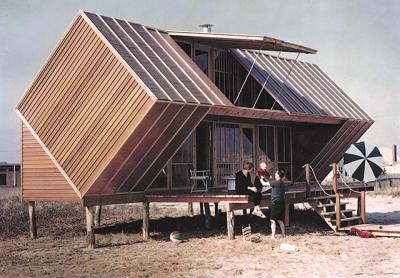Modernism, With Elephants in the Room in Southampton

Fifteen years ago, the journalist Warren Strugatch found himself “at a party on the East End, stuck between people like Jerry Della Femina and Christie Brinkley and surrounded by A-list characters, but it was so loud I couldn’t hear what all these people were saying to each other. I thought it would be interesting to find out.”
His curiosity led him to launch “Out of the Question,” a series of panel discussions during which prominent East Enders are invited to address issues of “national scope and local preoccupation.” This summer’s discussions at the Southampton Arts Center have taken on real estate, the art market, and the restaurant business.
Thursday night's topic, “Architecture: Does Modernism Still Matter?” will be tackled by Paul Goldberger, the Pulitzer Prize-winning architectural critic, Jake Gorst, a filmmaker, writer, and grandson of the Long Island Modernist architect Andrew Geller, and two architects, Robert Barnes of Barnes Coy and Anne Surchin, co-author of “Houses of the Hamptons: 1880-1930.”
While the subject might sound more scholarly than controversial, any discussion of architecture on Long Island is bound to move from the modest and often quirky beach houses of Geller and Peter Blake to the more mainstream East End work of such notable Modernists as Robert Gwathmey and Robert A.M. Stern to the elephants in the room — what Mr. Goldberger referred to during a recent conversation as “the tsunami of shingled traditional houses.”
Modernist architecture, which arose early in the 20th century, rejected traditional neo-Classical and Beaux-Arts styles in favor of purity, functionality, and the elimination of decoration. It was driven in part by new construction technologies such as the use of glass, steel, and reinforced concrete.
Many of the Modernist architects who became well known in the United States came from Europe, among them Mies van der Rohe, Marcel Breuer, and Albert Frey, who worked on Long Island in the early 1930s.
Mr. Gorst, who has directed documentaries on Modernist architecture on Long Island and in Southern California, noted that both were characterized by simplicity of design. “My grandfather worked for many years with the industrial designer Raymond Loewy, who believed the simpler the design, the more it resonated with people on a psychological level.”
While that simplicity can be found on both coasts, there were differences. “In Southern California, a lot of the houses have glass walls. You’re sitting in the dining room, but you’re also outside in the desert. On Long Island, it gets cold and it can be extremely windy. You don’t want sand to blow into your house here.”
Both Mr. Strugatch and Mr. Gorst cited another characteristic of the midcentury Long Island architects and their clients: a sense of humor. “The architects enjoyed flouting tradition, thumbing their noses at it,” said Mr. Strugatch.
Mr. Gorst said, “My grandfather wanted to give his clients a place to play. A lot of his clients wanted a place to escape their work environment and do something crazy.” He cited as an example the house Geller designed for Irwin and Joyce Hunt on Fire Island. “They wanted something that would turn heads. It wasn’t a huge departure, because in reality it was a rectangular box. The difference was that it was rotated on an axis so that it sat on a point. Like Blake’s Pinwheel House, it kind of skewed the original notion of Modernism for the purpose of having fun.”
According to Mr. Strugatch, the “double-diamond” Pearlroth House in Westhampton Beach, another Geller achievement, “almost looks like a pair of angular sunglasses. I think the spirit of humor and innovation are missing today. There’s not a lot of humor in McMansions.”
Mr. Goldberger also spoke of “a certain kind of modesty and understatement and simplicity of the post-World War II era that has had very little role in the world of the Hamptons during the last 30 or 40 years. We lost a huge number of important early-modern houses here, largely because the land was more valuable than the house. People tore them down to build McMansions.”
He is encouraged, however, by the direction of some recent architecture of the region. “What we’ve seen in the last few years is a substantial number of larger, more elaborate, more elegantly detailed, and more expensive modern houses that have the grandeur of true mansions but use a modern architectural vocabulary. There is more and more of that, and a lot of it is really good.”
One of the first of those extravagant modern houses, Toad Hall, was designed for Francois de Menil by Mr. Gwathmey. “It was important because it was one of the first times somebody had tried to do a really grand villa that was modern,” said Mr. Goldberger. “We’re seeing a lot of houses like that now. Some of them are exceptionally beautiful and well done and refreshing. That’s one kind of modern house.”
He went on, however, to question whether there is anything on the East End that’s modern in the sense of “pushing forward the boundaries of architecture. There is less of that. I wouldn’t say absolutely zero, but not a huge amount. The house that Diller Scofidio and Renfro just did at the end of Two Mile Hollow Road [in East Hampton] is perhaps one example of a house that really pushes the envelope in different ways.”
As Mr. Goldberger sees it, Modernism can be represented by both cutting-edge architecture and architecture that uses a modern vocabulary without trying to redefine what architecture can be. “I hope one of the things that will come out of this discussion will be an opportunity to talk a bit on both sides of this equation.”
Tickets to Thursday night's program, which will begin at 7, are $15. A reception will follow the program.
